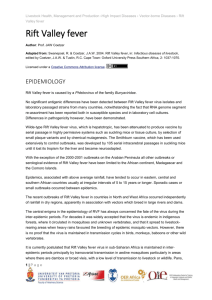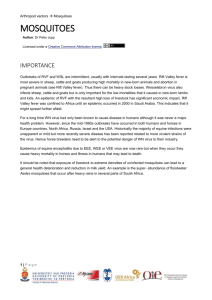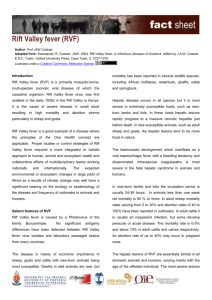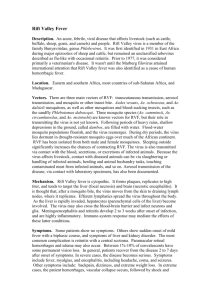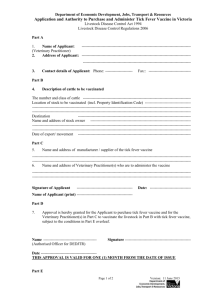06_rift_valley_fever_control_and_prevention
advertisement
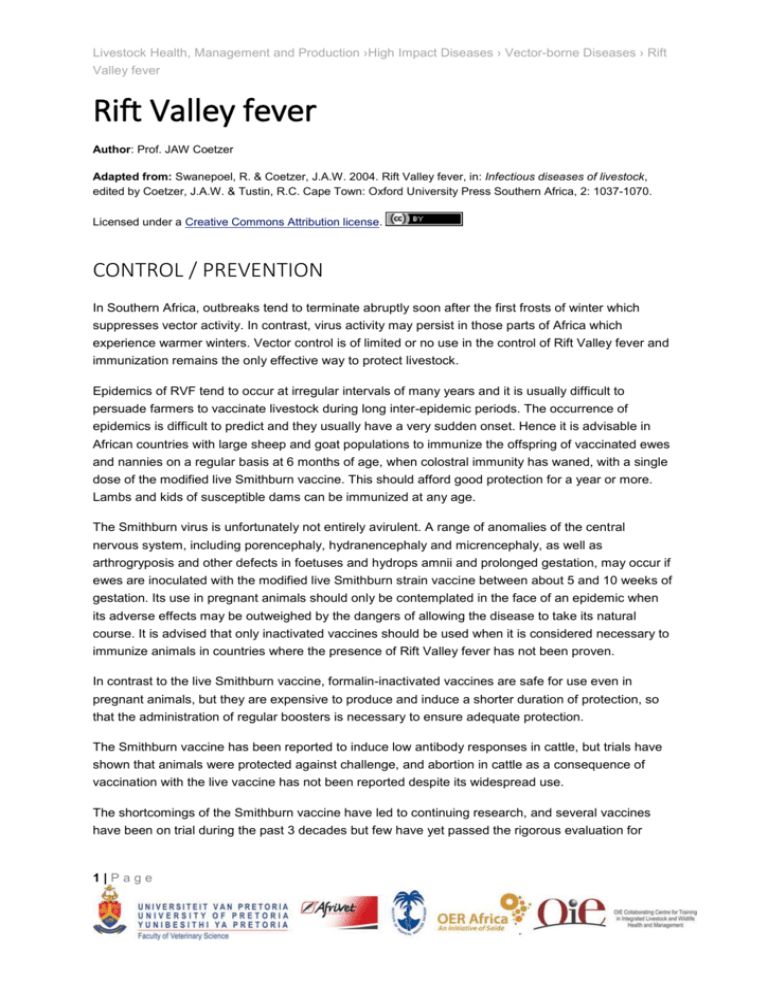
Livestock Health, Management and Production ›High Impact Diseases › Vector-borne Diseases › Rift Valley fever Rift Valley fever Author: Prof. JAW Coetzer Adapted from: Swanepoel, R. & Coetzer, J.A.W. 2004. Rift Valley fever, in: Infectious diseases of livestock, edited by Coetzer, J.A.W. & Tustin, R.C. Cape Town: Oxford University Press Southern Africa, 2: 1037-1070. Licensed under a Creative Commons Attribution license. CONTROL / PREVENTION In Southern Africa, outbreaks tend to terminate abruptly soon after the first frosts of winter which suppresses vector activity. In contrast, virus activity may persist in those parts of Africa which experience warmer winters. Vector control is of limited or no use in the control of Rift Valley fever and immunization remains the only effective way to protect livestock. Epidemics of RVF tend to occur at irregular intervals of many years and it is usually difficult to persuade farmers to vaccinate livestock during long inter-epidemic periods. The occurrence of epidemics is difficult to predict and they usually have a very sudden onset. Hence it is advisable in African countries with large sheep and goat populations to immunize the offspring of vaccinated ewes and nannies on a regular basis at 6 months of age, when colostral immunity has waned, with a single dose of the modified live Smithburn vaccine. This should afford good protection for a year or more. Lambs and kids of susceptible dams can be immunized at any age. The Smithburn virus is unfortunately not entirely avirulent. A range of anomalies of the central nervous system, including porencephaly, hydranencephaly and micrencephaly, as well as arthrogryposis and other defects in foetuses and hydrops amnii and prolonged gestation, may occur if ewes are inoculated with the modified live Smithburn strain vaccine between about 5 and 10 weeks of gestation. Its use in pregnant animals should only be contemplated in the face of an epidemic when its adverse effects may be outweighed by the dangers of allowing the disease to take its natural course. It is advised that only inactivated vaccines should be used when it is considered necessary to immunize animals in countries where the presence of Rift Valley fever has not been proven. In contrast to the live Smithburn vaccine, formalin-inactivated vaccines are safe for use even in pregnant animals, but they are expensive to produce and induce a shorter duration of protection, so that the administration of regular boosters is necessary to ensure adequate protection. The Smithburn vaccine has been reported to induce low antibody responses in cattle, but trials have shown that animals were protected against challenge, and abortion in cattle as a consequence of vaccination with the live vaccine has not been reported despite its widespread use. The shortcomings of the Smithburn vaccine have led to continuing research, and several vaccines have been on trial during the past 3 decades but few have yet passed the rigorous evaluation for 1|Page Livestock Health, Management and Production ›High Impact Diseases › Vector-borne Diseases › Rift Valley fever successful registration. A new avirulent candidate virus (clone 13), was found to be safe and efficacious. Veterinarians and others engaged in the livestock industry should remain vigilant of the potential dangers of exposure to zoonotic agents in handling tissues of diseased animals, and precautions should be increased during Rift Valley fever epidemics. Protective clothing such as gloves and masks should be used when doing necropsies on suspected cases of RVF or handling infected tissues. No vaccine is currently freely available to protect humans against the disease. 2|Page


